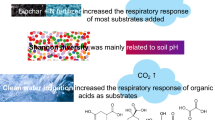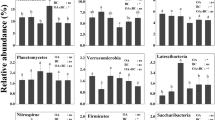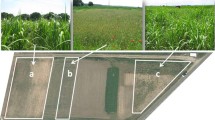Abstract
Background and aims
Within the last decades, considerable knowledge has been gained on the impacts of carbonaceous soil additives such as hydrochar (or HTC) and biochar (or pyrochar) on plant growth and various soil properties. However, still little is known about the effects of hydrochar and biochar on soil microorganisms, especially from field studies. Microorganisms are closely linked to nutrient dynamics in soil and therefore are tightly linked to soil fertility. As a consequence, possible changes in the microbial community structure due to HTC/biochar soil application may lead to considerable changes in soil nutrient dynamics.
Methods
To gain insights into HTC/biochar associated long-term effects on microorganisms, soil samples were taken from a grassland field study 2.6 years (31 months) after its initiation (April 2011), where Miscanthus × giganteus feedstock, HTC and biochar, each mixed with pig slurry had been applied as top-dressing in a randomized block design, next to a slurry-only control (n = 4, 16 plots). The samples were analyzed for microbial activity and biomass by substrate induced respiration (SIR). Bacterial and fungal fractions in soil microbial biomass (SMB) were determined using the inhibitors streptomycin and cycloheximide respectively.
Results
Total SMB in biochar-amended soils was significantly higher compared to all other treatments; fungal biomass was significantly higher compared to feedstock and control treatments. The percentage of bacterial biomass was higher in the feedstock and HTC amended soil, as compared to the control. Additionally, HTC exhibited a significantly higher percentage of fungal biomass compared to the feedstock treatment, indicating a microbial community shift.
Conclusion
While the uncarbonized feedstock material depleted both total SMB and especially fungi, HTC and biochar did not trigger any adverse long-term effects on SMB. Rather, the observed biochar-induced stimulation of SMB may improve soil aggregation and increase the soil organic carbon content in the long term.


Similar content being viewed by others
References
Allison V, Condron L, Peltzer D, Richardson S, Turner B (2007) Changes in enzyme activities and soil microbial community composition along carbon and nutrient gradients at the Franz Josef chronosequence. N Z Soil Biol Biochem 39:1770–1781
Ameloot N, De Neve S, Jegajeevagan K, Yildiz G, Buchan D, Funkuin YN, Prins W, Bouckaert L, Sleutel S (2013) Short-term CO2 and N2O emissions and microbial properties of biochar amended sandy loam soils. Soil Biol Biochem 57:401–410
Anderson J, Domsch K (1973) Quantification of bacterial and fungal contributions to soil respiration. Arch Mikrobiol 93:113–127. doi:10.1007/bf00424942
Anderson J, Domsch K (1975) Measurement of bacterial and fungal contributions to respiration of selected agricultural and forest soils. Can J Microbiol 21:314–322
Anderson TH, Domsch K (1986) Carbon assimilation and microbial activity in soil. Z Pflanzenernähr Bodenkd 149:457–468
Anderson TH, Domsch K (2010) Soil microbial biomass: the eco-physiological approach. Soil Biol Biochem 42:2039–2043
Anderson CR, Condron LM, Clough TJ, Fiers M, Stewart A, Hill RA, Sherlock RR (2011) Biochar induced soil microbial community change: implications for biogeochemical cycling of carbon, nitrogen and phosphorus. Pedobiologia 54:309–320
Baath E, Anderson TH (2003) Comparison of soil fungal/bacterial ratios in a pH gradient using physiological and PLFA-based techniques. Soil Biol Biochem 35:955–963. doi:10.1016/s0038-0717(03)00154-8
Badalucco L, Pomare F, Grego S, Landi L, Nannipieri P (1994) Activity and degradation of Streptomycin and Cycloheximide in soil. Biol Fertil Soils 18:334–340. doi:10.1007/bf00570637
Bargmann I, Martens R, Rillig MC, Kruse A, Kuecke M (2014) Hydrochar amendment promotes microbial immobilization of mineral nitrogen. J Plant Nutr Soil Sci 177:59–67. doi:10.1002/jpln.201300154
Boer W, Folman LB, Summerbell RC, Boddy L (2005) Living in a fungal world: impact of fungi on soil bacterial niche development. FEMS Microbiol Rev 29:795–811. doi:10.1016/j.femsre.2004.11.005
Castaldi S et al (2011) Impact of biochar application to a Mediterranean wheat crop on soil microbial activity and greenhouse gas fluxes. Chemosphere 85:1464–1471
Cleveland CC, Nemergut DR, Schmidt SK, Townsend AR (2007) Increases in soil respiration following labile carbon additions linked to rapid shifts in soil microbial community composition. Biogeochemistry 82:229–240
Clifton-Brown JC, Stampfl PF, Jones MB (2004) Miscanthus biomass production for energy in Europe and its potential contribution to decreasing fossil fuel carbon emissions. Glob Chang Biol 10:509–518. doi:10.1111/j.1529-8817.2003.00749.x
Dempster D, Gleeson D, Solaiman Z, Jones D, Murphy D (2012) Decreased soil microbial biomass and nitrogen mineralisation with Eucalyptus biochar addition to a coarse textured soil. Plant Soil 354:311–324
Diakite M, Paul A, Jaeger C, Pielert J, Mumme J (2013) Chemical and morphological changes in hydrochars derived from microcrystalline cellulose and investigated by chromatographic, spectroscopic and adsorption techniques. Bioresour Technol 150:98–105. doi:10.1016/j.biortech.2013.09.129
Drenovsky R, Vo D, Graham K, Scow K (2004) Soil water content and organic carbon availability are major determinants of soil microbial community composition. Microb Ecol 48:424–430
Eiland F, Klamer M, Lind A-M, Leth M, Bههth E (2001) Influence of initial C/N ratio on chemical and microbial composition during long term composting of straw. Microb Ecol 41:272–280
Funke A, Ziegler F (2011) Heat of reaction measurements for hydrothermal carbonization of biomass. Bioresour Technol 102:7595–7598
Funke A, Mumme J, Koon M, Diakite M (2013) Cascaded production of biogas and hydrochar from wheat straw: energetic potential and recovery of carbon and plant nutrients. Biomass Bioenergy 58:229–237. doi:10.1016/j.biombioe.2013.08.018
George C, Wagner M, Kuecke M, Rillig MC (2012) Divergent consequences of hydrochar in the plant-soil system: arbuscular mycorrhiza, nodulation, plant growth and soil aggregation effects. Appl Soil Ecol 59:68–72. doi:10.1016/j.apsoil.2012.02.021
Gomez JD, Denef K, Stewart CE, Zheng J, Cotrufo MF (2014) Biochar addition rate influences soil microbial abundance and activity in temperate soils. Eur J Soil Sci 65:28–39. doi:10.1111/ejss.12097
Hammel K (1997) Fungal degradation of lignin. In: Cadisch G, Giller KE (eds) Driven by nature: plant litter quality and decomposition. CAB International, Wallingford, pp 33–45
Hammer EC, Balogh-Brunstad Z, Jakobsen I, Olsson PA, Stipp SL, Rillig MC (2014) A mycorrhizal fungus grows on biochar and captures phosphorus from its surfaces. Soil Biol Biochem 77:252–260
Hatakka A (1994) Lignin-modifying enzymes from selected white-rot fungi: production and role from in lignin degradation. FEMS Microbiol Rev 13:125–135
Heaton EA, Dohleman FG, Long SP (2008) Meeting US biofuel goals with less land: the potential of Miscanthus. Glob Chang Biol 14:2000–2014. doi:10.1111/j.1365-2486.2008.01662.x
Hobara S, Osono T, Hirose D, Noro K, Hirota M, Benner R (2014) The roles of microorganisms in litter decomposition and soil formation. Biogeochemistry 118:471–486. doi:10.1007/s10533-013-9912-7
Hu J, Wu F, Wu S, Lam CL, Lin X, Wong MH (2014) Biochar and Glomus caledonium influence Cd accumulation of Upland Kangkong (Ipomoea aquatica Forsk.) intercropped with Alfred Stonecrop (Sedum alfredii Hance). Sci Rep 4 doi:10.1038/srep04671
Jangid K, Williams MA, Franzluebbers AJ, Schmidt TM, Coleman DC, Whitman WB (2011) Land-use history has a stronger impact on soil microbial community composition than aboveground vegetation and soil properties. Soil Biol Biochem 43:2184–2193
Jenkinson DS, Ladd JN (1981) Microbial biomass in soil: measurement and turnover. In: Paul EA, Ladd JN (eds), Soil biochemistry, vol 5. Marcel Dekker, New York, pp 415–471
Jin H (2010) Characterization of microbial life colonizing biochar and biochar-amended soils. Cornell University
Kolb SE, Fermanich KJ, Dornbush ME (2009) Effect of charcoal quantity on microbial biomass and activity in temperate soils. Soil Sci Soc Am J 73:1173–1181. doi:10.2136/sssaj2008.0232
Kolton M, Harel YM, Pasternak Z, Graber ER, Elad Y, Cytryn E (2011) Impact of biochar application to soil on the root-associated bacterial community structure of fully developed greenhouse pepper plants. Appl Environ Microbiol 77:4924–4930
Kruse A, Funke A, Titirici M-M (2013) Hydrothermal conversion of biomass to fuels and energetic materials. Curr Opin Chem Biol 17:515–521. doi:10.1016/j.cbpa.2013.05.004
Lavahun M, Joergensen R, Meyer B (1996) Activity and biomass of soil microorganisms at different depths. Biol Fertil Soils 23:38–42
Lehmann J, Rillig MC, Thies J, Masiello CA, Hockaday WC, Crowley D (2011) Biochar effects on soil biota–a review. Soil Biol Biochem 43:1812–1836
Libra JA et al (2011) Hydrothermal carbonization of biomass residuals: a comparative review of the chemistry, processes and applications of wet and dry pyrolysis. Biofuels 2:71–106
Lin Q, Brookes PC (1999) An evaluation of the substrate-induced respiration method. Soil Biol Biochem 31:1969–1983. doi:10.1016/s0038-0717(99)00120-0
Luo Y, Durenkamp M, De Nobili M, Lin Q, Devonshire BJ, Brookes PC (2013) Microbial biomass growth, following incorporation of biochars produced at 350 degrees C or 700 degrees C, in a silty-clay loam soil of high and low pH. Soil Biol Biochem 57:513–523. doi:10.1016/j.soilbio.2012.10.033
Marschner P, Kandeler E, Marschner B (2003) Structure and function of the soil microbial community in a long-term fertilizer experiment. Soil Biol Biochem 35:453–461. doi:10.1016/s0038-0717(02)00297-3
Muhammad N et al (2014) Changes in microbial community structure due to biochars generated from different feedstocks and their relationships with soil chemical properties. Geoderma 226:270–278. doi:10.1016/j.geoderma.2014.01.023
Neely CL, Beare MH, Hargrove WL, Coleman DC (1991) Relationships between fungal and bacterial substrate-induced respiration, biomass and plant residue decomposition. Soil Biol Biochem 23:947–954. doi:10.1016/0038-0717(91)90175-j
Ocio J, Martinez J, Brookes P (1991) Contribution of straw-derived N to total microbial biomass N following incorporation of cereal straw to soil. Soil Biol Biochem 23:655–659
Peacock AD, Mullen MD, Ringelberg DB, Tyler DD, Hedrick DB, Gale PM, White DC (2001) Soil microbial community responses to dairy manure or ammonium nitrate applications. Soil Biol Biochem 33:1011–1019. doi:10.1016/s0038-0717(01)00004-9
Powlson D, Prookes P, Christensen BT (1987) Measurement of soil microbial biomass provides an early indication of changes in total soil organic matter due to straw incorporation. Soil Biol Biochem 19:159–164
Pyter R, Heaton E, Dohleman F, Voigt T, Long S (2009) Agronomic experiences with Miscanthus x giganteus in Illinois, USA. In: Mielenz JR (ed) Biofuels methods and protocols, vol 581. Humana Press, New York, pp 41–52. doi:10.1007/978-1-60761-214-8_3
Quilliam RS, Marsden KA, Gertler C, Rousk J, DeLuca TH, Jones DL (2012) Nutrient dynamics, microbial growth and weed emergence in biochar amended soil are influenced by time since application and reapplication rate. Agric Ecosyst Environ 158:192–199. doi:10.1016/j.agee.2012.06.011
Quilliam RS, Glanville HC, Wade SC, Jones DL (2013) Life in the ‘charosphere’–Does biochar in agricultural soil provide a significant habitat for microorganisms? Soil Biol Biochem 65:287–293
Rillig MC et al (2010) Material derived from hydrothermal carbonization: effects on plant growth and arbuscular mycorrhiza. Appl Soil Ecol 45:238–242. doi:10.1016/j.apsoil.2010.04.011
Saito M (1990) Charcoal as a micro-habitat for VA mycorrhizal fungi, and its practical implication. Agric Ecosyst Environ 29:341–344
Saito M, Marumoto T (2002) Inoculation with arbuscular mycorrhizal fungi: the status quo in Japan and the future prospects. In: Smith S, Smith FA (eds), Diversity and integration in mycorrhizas. Springer, Netherlands, pp 273–279
Salem M, Kohler J, Rillig MC (2013a) Palatability of carbonized materials to Collembola. Appl Soil Ecol 64:63–69. doi:10.1016/j.apsoil.2012.10.009
Salem M, Kohler J, Wurst S, Rillig MC (2013b) Earthworms can modify effects of hydrochar on growth of Plantago lanceolata and performance of arbuscular mycorrhizal fungi. Pedobiologia 56:219–224. doi:10.1016/j.pedobi.2013.08.003
Sang T, Zhu W (2011) China's bioenergy potential. Glob Chang Biol Bioenergy 3:79–90. doi:10.1111/j.1757-1707.2010.01064.x
Schimmelpfennig S, Glaser B (2012) One step forward toward characterization: some important material properties to distinguish biochars. J Environ Qual 41:1001–1013
Schimmelpfennig S, Mueller C, Gruenhage L, Koch C, Kammann C (2014) Biochar, hydrochar and uncarbonized feedstock application to permanent grassland-Effects on greenhouse gas emissions and plant growth. Agric Ecosyst Environ 191:39–52. doi:10.1016/j.agee.2014.03.027
Schimmelpfennig S, Kammann C, Moser G, Grünhage L, Müller C (2015) Changes in macro‐and micronutrient contents of grasses and forbs following Miscanthus x giganteus feedstock, hydrochar and biochar application to temperate grassland. Grass Forage Sci. doi:10.1111/gfs.12158
Singh BP, Cowie AL, Smernik RJ (2012) Biochar carbon stability in a clayey soil as a function of feedstock and pyrolysis temperature. Environ Sci Technol 46:11770–11778
Steinbeiss S, Gleixner G, Antonietti M (2009) Effect of biochar amendment on soil carbon balance and soil microbial activity. Soil Biol Biochem 41:1301–1310. doi:10.1016/j.soilbio.2009.03.016
Sun D, Meng J, Chen W (2013) Effects of abiotic components induced by biochar on microbial communities. Acta Agric Scand Sect B-Soil Plant Sci 63:633–641. doi:10.1080/09064710.2013.838991
Taghizadeh-Toosi A, Clough TJ, Condron LM, Sherlock RR, Anderson CR, Craigie RA (2011) Biochar incorporation into pasture soil suppresses in situ nitrous oxide emissions from ruminant urine patches. J Environ Qual 40:468–476. doi:10.2134/jeq2010.0419
Titirici M-M, Thomas A, Antonietti M (2007) Back in the black: hydrothermal carbonization of plant material as an efficient chemical process to treat the CO2 problem? New J Chem 31:787–789
Vanveen JA, Ladd JN, Frissel MJ (1984) Modeling C and N turnover through the microbial biomass in soil. Plant Soil 76:257–274
Vanveen JA, Ladd JN, Amato M (1985) Turnover of carbon and nitrogen through the microbial biomass in a sandy loam and a clay soil incubated with [14C(U)] glucose and [15N](NH4)2SO4 under different moisture regimes. Soil Biol Biochem 17:747–756. doi:10.1016/0038-0717(85)90128-2
Waldrop MP, Firestone MK (2004) Microbial community utilization of recalcitrant and simple carbon compounds: impact of oak-woodland plant communities. Oecologia 138:275–284
WRB (2006) World reference base for soil resources 2006 vol 103
Acknowledgments
We thank Gerhard Mayer, Nicol Strasilla and Christian Eckhardt for providing technical assistance with the experimental setup. This study was financed by the Hessian Agency for Environment and Geology, Germany.
Author information
Authors and Affiliations
Corresponding author
Additional information
Responsible Editor: Simon Jeffery.
Electronic supplementary material
Below is the link to the electronic supplementary material.
Figure S1
Measurement result of a single jar with control soil during basal respiration of SIR (a) and during plateau period of SIR (b), given by Licor 8100. (JPEG 97 kb)
Figure S2
General scheme of SIR, based on the findings of Anderson and Domsch (1973) and DIN ISO (17155:2011–06 2011). (JPEG 41 kb)
Figure S3
Absolute and percental fractions of bacteria and fungi in total respiration. (JPEG 78.1 kb)
Rights and permissions
About this article
Cite this article
Rex, D., Schimmelpfennig, S., Jansen-Willems, A. et al. Microbial community shifts 2.6 years after top dressing of Miscanthus biochar, hydrochar and feedstock on a temperate grassland site. Plant Soil 397, 261–271 (2015). https://doi.org/10.1007/s11104-015-2618-y
Received:
Accepted:
Published:
Issue Date:
DOI: https://doi.org/10.1007/s11104-015-2618-y




